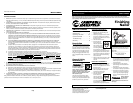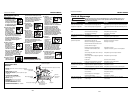
Cómo usar la
Clavadora (Continuación)
6. Remueva la
clavadora de la
superficie de
trabajo. El
Elemento de
Contacto de
Trabajo tiene que volver a su posi-
ción original. La clavadora NO
DEBE OPERAR. No use la her-
ramienta si opera mientras está lev-
antada de la superficie de trabajo.
7. Apriete el
gatillo y pre-
sione el
Elemento de
Contacto de
Trabajo contra la superficie de tra-
bajo. La clavadora NO DEBE hacerse
funcionar.
8. Presione el
Elemento de
Contacto de
Trabajo contra
la superficie de
trabajo. Apriete el gatillo. La
clavadora DEBE OPERAR.
Una
herramienta que funciona de manera
inadecuada no debe usarse. No active
la herramienta a menos que esté
colocada firmemente contra la pieza de
trabajo.
PARA CARGAR Y DESCARGAR LA
CLAVADORA
1. Siempre conecte la herramienta a
la fuente de suminsitro de aire
antes de colocarle los clavos.
2. Tire el mecanismo de impulso (B)
hacia atrás hasta que la guía de
empuje quede detrás de los clavos.
!
ADVERTENCIA
Introduzca tiras de clavos en la
parte trasera del cargador (A).
3. No cargue sin que esté asegurado,
ni con el gatillo apretado.
4. Siempre descargue el sujetador
antes de remover la herramienta de
servicio. La descarga se hace
siguiendo el proceso inverso de la
carga; sin embargo, siempre se
tiene que desconectar la
manguera de aire antes de descar-
garla.
CÓMO AJUSTAR LA PENETRACIÓN
DEL CLAVO
La CHN201 viene equipada con un
mecanismo clavador de profundidad
ajustable. Esto le permite al usuario
determinar a qué profundidad se va a
clavar en la superficie de trabajo.
1. Ajuste la presión de operación a aquél-
la que usará con regularidad para
clavar los clavos. No exceda la presión
de operación máxima de la clavadora
modelo NB0064 de 7,58 bar.
2. Para dirigir el calador de clavos, gire
la rueda (C) hacia la derecha hasta
el punto deseado.
3. Para clavar el clavo más profundo,
gire la rueda (C) hacia la izquierda
hasta el punto deseado.
4. Asegúrese que el
gatillo y el
Elemento de
Contacto de
Trabajo se mueven
libremente hacia
arriba y hacia abajo sin atascarse o
pegarse después de cada ajuste.
PARA AJUSTAR LA DIRECCION DEL
TUBO DE ESCAPE
La clavadora mod-
elo CHN201 está
equipada con un
deflector ajustable
de la dirección del
tubo de escape. Éste le permite al
usuario cambiar la dirección del tubo
de escape. Simplemente mueva el
deflector hacia la dirección deseada.
QUE HACER CUANDO LA CLAVADO-
RA TENGA UN CLAVO ATASCADO
1. Desconecte la
clavadora de la
fuente de sum-
inistro de aire.
2. Remueva todos
los clavos del
depósito (vea
Carga /
Descarga).
3. Destrabe el gan-
cho presionando
el botón en el
lado del car-
gador. El botón
destrabará el gancho de la boquil-
la.
4. Ahora se puede
rotar la puerta,
dejando el clavo
atascado
expuesto.
5. Saque el clavo
atascado con
un alicate o
destornillador,
si es necesario.
6 Gire la puerta
hacia atrás a la
posición cerrada.
7. Vuelva a presion-
ar el botón para
levantar el gan-
cho. Cierre la
puerta y suelte el
botón para volver
a trabar el gancho con la boquilla.
Modelo CHN201
5-Sp
Manual de Instrucciones
Rotate
Gire
1 2
1 2
(B)
(A)
(C)
Operating The Nailer
(Continued)
RECOMMENDED HOOKUP
The illustration below shows the
recommended hookup for the nailer.
1. The air com-
pressor must be
able to main-
tain a minimum
of 70 psi when
the nailer is being used. An inade-
quate air supply can cause a loss of
power and inconsistent
driving.
2. An oiler can be
used to provide oil
circulation through
the nailer. A filter
can be used to
remove liquid and solid impurities
which can rust or “gum up” internal
parts of the nailer.
3. Always use air supply hoses with a
minimum working pressure rating
equal to or greater than the pres-
sure from the power source if a reg-
ulator fails, or 150 psi, whichever is
greater. Use 3/8” air hose for runs
up to 50’. Use 1/2” air hoses for 50’
run or longer. For better perfor-
mance, install a 3/8” quick plug
(1/4” NPT threads) with an inside
diameter of .315” (8mm) on the
nailer and a 3/8” quick coupler on
the air hose.
4. Use a pressure regulator on the
compressor, with an operating pres-
sure of 0 - 125 psi. A pressure regu-
lator is required to control the oper-
ating pressure of the nailer
between 70 and 110 psi.
4. Reconnect air
supply to the
nailer.
5. Depress the
Work Contact
Element (WCE)
against the
work surface
without pulling the trigger. The
nailer MUST NOT OPERATE. Do not
use the tool if it operates without
pulling the trigger. Personal injury
may result.
6. Remove the
nailer from the
work surface.
The Work
Contact
Element (WCE) must return to its
original down position. The nailer
MUST NOT OPERATE. Do not use
the tool if it operates while lifted
from the work surface. Personal
injury may result.
7. Pull the trig-
ger and
depress the
work contact
element
(WCE) against the work surface. The
nailer MUST NOT OPERATE.
8. Depress the
Work Contact
Element
(WCE) against
the work sur-
face. Pull the trigger. The nailer
MUST OPERATE.
An improperly
functioning tool
must not be used. Do not actuate the
tool unless the tool is placed firmly
against the work piece.
LOADING/UNLOADING THE NAILER
1. Always connectthe tool to the air
supply before loading fasteners.
!
WARNING
OPERATIONAL MODE
Always know the
operational mode
of the nailer before using. Failure to
know the operational mode could
result in death or serious personal
injury.
SINGLE CYCLE MODE
This mode
requires the trig-
ger to be pulled
each time a nail
is driven. The
nailer can be actuated by depressing
the WCE against the work surface fol-
lowed by pulling the trigger.
The trigger must be released to reset
the tool before another nail can be dri-
ven.
WORK CONTACT ELEMENT (WCE)
Check the opera-
tion of the Work
Contact Element (WCE) trip mechanism
before each use. The WCE must move
freely without binding through its
entire travel distance. The WCE spring
must return the WCE to its fully extend-
ed position after being depressed. Do
not operate the nailer if the WCE trip
mechanism is not operating properly.
Personal injury may occur.
1. Disconnect the
air supply from
the nailer.
2. Remove all
nails from the
magazine (see
Loading/
Unloading).
3. Make sure the
trigger and
work contact
element (WCE)
move freely up
and down without sticking or bind-
ing.
!
CAUTION
!
WARNING
Model CHN201
Operating Instructions
4
1
1 2
1 2
CAMPBELL
PROFESSIONAL
HAUSFELD
movement
www.chpower.com
70 psi
Min.
110 psi
Max.
150 psi or greater
3/8” I.D.
BUILT TO LAST
BUILT TO LAST
BUILT TO LAST
BUILT TO LAST
BUILT TO LAST
BUILT TO LAST
BUILT TO LAST














